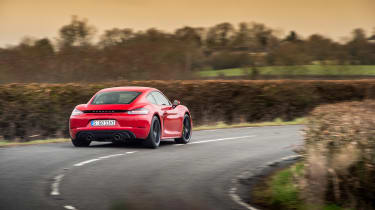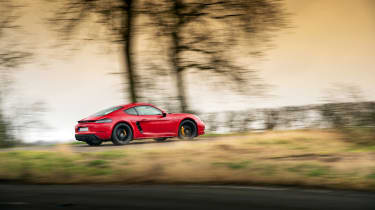Porsche 718 Cayman review – performance and 0-60
Even the entry-level Cayman is quick, and the turbo engines punch hard. Sixes need working harder, but the rewards are far greater
Even in its least powerful form, the Cayman can cover the 0-62mph measure in 5.1sec and tops out at 170mph – not bad for Porsche’s entry-level sports car. Opt for the PDK version and the acceleration times drop by two-tenths, while the Sport Chrono Package (PDK only) cuts that by a further two-tenths.
With a sixth more power, the Cayman S goes quicker still. In manual form it reaches 62mph in 4.6sec, but this is cut to 4.4sec and 4.2sec with the PDK and Sport Chrono respectively. Top speed, meanwhile, rises to 177mph.
This is where the four-cylinder engine range ends, but it’s where unease over the four-cylinder layout begins. Objectively, there’s not a great deal to fault with the flat-fours. Performance has risen, low-down torque has improved (even if the engines are less linear than the old sixes), and when they’re spinning away at high revs, throttle response is still pretty good. They work well with both gearbox options, too, the manual in particular remaining a joy to slot around the gate.
It’s just a crying shame that they sound the way they do. If either engine had the offbeat growl of an old Impreza it might be easier to forgive, but instead both units have a harsh, uncultured tone that feels more hot hatch than sports car (in fact, some hot hatches sound better). And if you specify the sports exhaust, it sounds like an old Beetle with a blowing silencer.
More reviews
In-depth reviews
Reviews
Better, instead, to move on to the six-cylinder models in the range. Yawning gear ratios – second will get you to 85mph – take the edge off the flat-six’s performance and limit how much of the wonderful sound the engine produces at high revs can be enjoyed on the road. It can also make the Cayman feel slightly slovenly out of tight corners unless you’re prepared to change down to first a lot more often than you would in other cars.
But, good lord, is the experience worth it when you do. It’s a reminder of why we were so displeased about the move to four cylinders in the first place; the six-pot is smooth, cultured and sharp as a Sabatier-sliced lemon, its power building throughout the rev range to a crescendo by the 8000rpm limiter.
While the gears are long, the gearbox itself is a joy – matched, as always, to a perfectly weighted clutch. Rev-matching on downshifts feels as natural as walking, but if you prefer, you can let the car do that with a switch on the centre console, for perfect heel-and-toe shifts every time. And flat out, on a circuit, naturally, it’s hard to imagine wanting any more performance.





